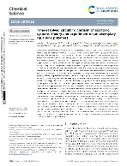| dc.contributor.author | Ress, Lea | |
| dc.contributor.author | Malý, Pavel | |
| dc.contributor.author | Landgraf, Jann B. | |
| dc.contributor.author | Lindorfer, Dominik | |
| dc.contributor.author | Hofer, Michael | |
| dc.contributor.author | Selby, Joshua | |
| dc.contributor.author | Lambert, Christoph | |
| dc.contributor.author | Renger, Thomas | |
| dc.contributor.author | Brixner, Tobias | |
| dc.date.accessioned | 2024-03-04T09:13:31Z | |
| dc.date.available | 2024-03-04T09:13:31Z | |
| dc.date.issued | 2023 | |
| dc.identifier.uri | https://hdl.handle.net/20.500.14178/2354 | |
| dc.description.abstract | Experimental and theoretical foundations for femtosecond time-resolved circular dichroism (TRCD) spectroscopy of excitonic systems are presented. In this method, the system is pumped with linearly polarized light and the signal is defined as the difference between the transient absorption spectrum probed with left and with right circularly polarized light. We present a new experimental setup with a polarization grating as key element to generate circularly polarized pulses. Herein the positive (negative) first order of the diffracted light is left-(right-)circularly polarized and serves as a probe pulse in a TRCD experiment. The grating is capable of transferring ultrashort broadband pulses ranging from 470 nm to 720 nm into two separate beams with opposite ellipticity. By applying a specific chopping scheme we can switch between left and right circular polarizations and detect transient absorption (TA) and TRCD spectra on a shot-to-shot basis simultaneously. We perform experiments on a squaraine polymer, investigating excitonic dynamics, and we develop a general theory for TRCD experiments of excitonically coupled systems that we then apply to describe the experimental data in this particular example. At a magic angle of 54.7 & DEG; between the pump-pulse polarization and the propagation direction of the probe pulse, the TRCD and TA signals become particularly simple to analyze, since the orientational average over random orientations of complexes factorizes into that of the interaction with the pump and the probe pulse, and the intrinsic electric quadrupole contributions to the TRCD signal average to zero for isotropic samples. Application of exciton theory to linear absorption and to linear circular dichroism spectra of squaraine polymers reveals the presence of two fractions of polymer conformations, a dominant helical conformation with close interpigment distances that are suggested to lead to short-range contributions to site energy shifts and excitonic couplings of the squaraine molecules, and a fraction of unfolded random coils. Theory demonstrates that TRCD spectra of selectively excited helices can resolve state populations that are practically invisible in TA spectroscopy due to the small dipole strength of these states. A qualitative interpretation of TRCD and TA spectra in the spectral window investigated experimentally is offered. The 1 ps time component found in these spectra is related to the slow part of exciton relaxation obtained between states of the helix in the low-energy half of the exciton manifold. The dominant 140 ps time constant reflects the decay of excited states to the electronic ground state. | en |
| dc.language.iso | en | |
| dc.relation.url | https://doi.org/10.1039/d3sc01674a | |
| dc.rights | Creative Commons Uveďte původ 3.0 Unported | cs |
| dc.rights | Creative Commons Attribution 3.0 Unported | en |
| dc.title | Time-resolved circular dichroism of excitonic systems: theory and experiment on an exemplary squaraine polymer | en |
| dcterms.accessRights | openAccess | |
| dcterms.license | https://creativecommons.org/licenses/by/3.0/legalcode | |
| dc.date.updated | 2024-03-04T09:13:31Z | |
| dc.subject.keyword | Time-resolved spectroscopy | en |
| dc.subject.keyword | Circular dichroism | en |
| dc.subject.keyword | Chiral spectroscopy | en |
| dc.relation.fundingReference | info:eu-repo/grantAgreement/UK/COOP/COOP | |
| dc.date.embargoStartDate | 2024-03-04 | |
| dc.type.obd | 73 | |
| dc.type.version | info:eu-repo/semantics/publishedVersion | |
| dc.identifier.doi | 10.1039/d3sc01674a | |
| dc.identifier.utWos | 001051940400001 | |
| dc.identifier.eidScopus | 2-s2.0-85169509366 | |
| dc.identifier.obd | 643792 | |
| dc.identifier.pubmed | 37712031 | |
| dc.subject.rivPrimary | 10000::10300::10301 | |
| dc.subject.rivSecondary | 10000::10400::10403 | |
| dcterms.isPartOf.name | Chemical Science | |
| dcterms.isPartOf.issn | 2041-6520 | |
| dcterms.isPartOf.journalYear | 2023 | |
| dcterms.isPartOf.journalVolume | 14 | |
| dcterms.isPartOf.journalIssue | 35 | |
| uk.faculty.primaryId | 116 | |
| uk.faculty.primaryName | Matematicko-fyzikální fakulta | cs |
| uk.faculty.primaryName | Faculty of Mathematics and Physics | en |
| uk.department.primaryId | 1191 | |
| uk.department.primaryName | Fyzikální ústav UK | cs |
| uk.department.primaryName | Institute of Physics of Charles University | en |
| dc.description.pageRange | 9328-9349 | |
| dc.type.obdHierarchyCs | ČLÁNEK V ČASOPISU::článek v časopisu::původní článek | cs |
| dc.type.obdHierarchyEn | JOURNAL ARTICLE::journal article::original article | en |
| dc.type.obdHierarchyCode | 73::152::206 | en |
| uk.displayTitle | Time-resolved circular dichroism of excitonic systems: theory and experiment on an exemplary squaraine polymer | en |

